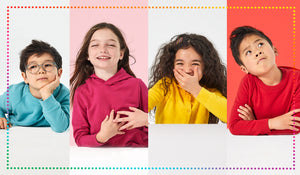Five Things I Wish You Knew About My Autistic Child
Our guest contributor, Nicole Gottesmann, shares insight about her son Gabe, who lives with non-speaking Autism.

Autism Acceptance Month is a chance for all of us to educate ourselves on what Autism is in its many forms, and how we can support parents with children on the Autism spectrum. Nicole Gottesmann is an influencer who showcases life with her son Gabe, who lives with non-speaking autism. Here, she shares five things she wishes people knew:
Presume competence.
Even though Gabe is non-speaking, that doesn't mean he doesn’t understand what you are saying or what is happening around him. Far too often, when a person is labeled “low-functioning,” it is assumed that they are intellectually disabled. This is not the case for many, and it’s one of the most important things I would like everyone to remember about Gabe and others like him! Gabe knows more than you might think in spite of being labeled as low-functioning or severely autistic. He understands even though he may have difficulty responding (or may not respond at all). That’s why it’s so important to always presume competence: to assume autistic people have the ability to learn and understand. Don’t underestimate Gabe or other non-speaking autistics!
Behavior is communication.
Although someone may not be able to speak, it doesn’t mean they have nothing to say! Gabe communicates in a variety of ways, even though he is non-speaking. He uses his voice sometimes although he isn’t able to speak in sentences. He also has an Augmentative and Alternative Communication device, or AAC device for short. Gabe currently uses a device called Touch Chat, but there are so many great AAC device options out there for non-speakers. Many non-speakers can also type, write, or use a letter board. Gabe excels at communicating his feelings physically and through eye contact! It’s almost as if he can stare into your eyes and see your soul. Gabe also uses self stimulatory behavior (stimming) to communicate his feelings. Some autistic children and adults flap their hands when they’re happy, and some twirl or jump like Gabe. Behavior is another form of communication for non-speaking autistics, especially when there are no other options accessible. All children and adults with non-speaking autism have a right to communicate and should have access to a communication device!
Inclusion matters.
My child wants social connection and to be included just like everyone else! Gabe has the desire and ability to connect with people in a way that is deep and meaningful even though he is non-speaking. There are countless people in his life with whom he has formed long term bonds. I love to watch him interact with others because it is so beautiful and unique. He’s extremely close with my sister who lives in NY. When she comes to visit us in Maryland he gets so excited and all the stims come out! I love it! He is the most affectionate person I know — he's always either hugging, kissing, playing with your hair, or staring deep into your eyes. He makes you feel special! I wish more people would try to get to know him and others like him. Gabe is such a joy to be around even though he doesn’t communicate in the same way most people do.
Look for hidden talents.
We discovered this summer that Gabe can sing with perfect pitch! I’ve since learned that this is common for autistic people who are non-speaking — it’s actually another form of communication. Music is a universal language, and Gabe has a great ear for it. He is almost always listening to or singing something, whether it’s a pop song from the radio or his favorite, classic rock (Right now, his favorite artist is Queen.)! Gabe also uses music to self-regulate at times. When he is upset or needs help, he sings “Another One Bites the Dust” by Queen in a fast paced and irritated tone. Sometimes when he's trying to do something that scares him, like ride a bike, he sings the entire time as a way to keep himself calm. Recently, a couple of musicians heard a recording I made of Gabe singing as we were walking down the street and they decided to make his melody into a real song. Hearing Gabe’s voice incorporated into the song Just Sing by Aryeh Kunstler is the most incredible thing that’s ever happened to us. Singing is Gabe’s way of talking and his voice is so angelic it makes me break down and cry every time I hear the song. You can find the song Just Sing on Spotify and iTunes! All proceeds benefit non-speakers who are in need of AAC devices.
Being a tween is hard, no matter what.
Many of the challenges we are facing right now have nothing to do with Autism and everything to do with being a tween! Gabe is growing up and acts like a typical tween in a lot of ways. He has let us know that he wants to go to bed later and make his own decisions now. He is finding his voice and independence, and we are trying to give Gabe more independence as well. For example, Gabe now makes his breakfast and lunch with our help. He helps with the laundry, makes his bed, and he picks out his own clothes. The main difference I have noticed is that he wants to be alone more than usual. He’ll often push us away to let us know to give him space. I love that he is able to communicate this to us! He needs to be treated as anyone else his age even though he has Autism. There are things he needs help with, but he is still a human being and should be treated with dignity. It makes me sad when I hear him spoken to as if he’s a much younger child (I have heard teachers ask him if he has “to go potty.”). I hope people learn to treat Gabe and other tweens on the spectrum like any other 12-year-old.
Thank you so much, Nicole, for sharing your story with us! You can keep up with Nicole and Gabe on Instagram: @nicolegottesmann.
Tagged with:
More from Parenting
View all posts-
 Translation missing: en.blogs.article.posted_in Parenting
Translation missing: en.blogs.article.posted_in ParentingFabric Feature: What Does It Mean to Be GOTS Certified Organic?
-
 Translation missing: en.blogs.article.posted_in Parenting
Translation missing: en.blogs.article.posted_in Parenting100 Things to Fill Your Heart with Love
-
 Translation missing: en.blogs.article.posted_in Parenting
Translation missing: en.blogs.article.posted_in Parenting25 Great Questions to Ask at the Thanksgiving Kids' Table


